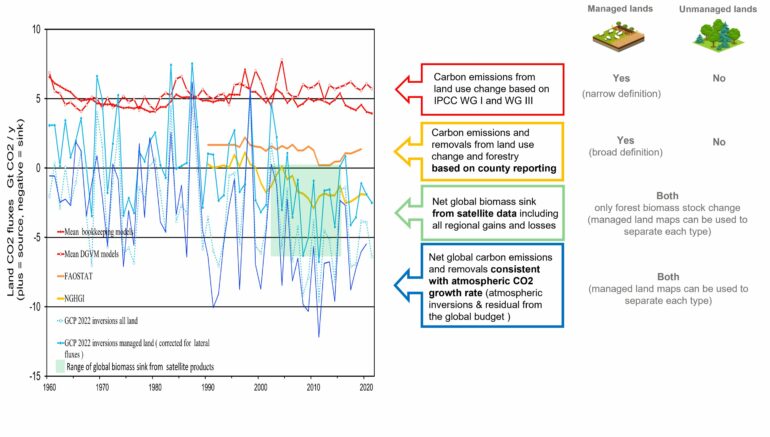A new study published in Nature demonstrates that estimates of current land-based emissions vary between scientific models and national greenhouse gas inventories due to differing definitions of what qualifies as “managed” land and human-induced, or anthropogenic removals on that land, and shows how global mitigation benchmarks change when accounting for land use, land-use change, and forestry (LULUCF) fluxes in scientific models from the national inventory perspective.
Effective management of land, whether for agriculture, forests, or settlements, plays a crucial role in addressing climate change and achieving future climate targets. Land use strategies to mitigate climate change include stopping deforestation along with enhancing forest management efforts.
Countries have recognized the importance of the LULUCF sector, with 118 of 143 countries including land-based emissions reductions and removals in their Nationally Determined Contributions (NDCs), which are at the heart of the Paris Agreement and the achievement of its long-term goals.
In their study, the research team underscores the necessity to compare like for like when assessing progress towards the Paris Agreement with countries needing to achieve more ambitious climate action when comparing their national starting points with global models.
“Countries estimate their LULUCF fluxes (emissions and removals) differently. Direct fluxes are a result of direct human intervention, such as agriculture and forest harvest. The models in the Assessment Reports by the Intergovernmental Panel on Climate Change (IPCC) use this accounting approach to determine the remaining carbon budget and the timing for achieving net-zero emissions.”
“Indirect fluxes are the response of land to indirect human-induced environmental changes, such as increase in atmospheric CO2 or nitrogen deposition that both enhance carbon removal,” explains Giacomo Grassi, a study co-author and researcher with the Joint Research Centre at the European Commission.
Grassi points out that it is practically not possible to separate direct and indirect fluxes through observations such as national forest inventories or remote sensing. Therefore, national greenhouse gas inventory methods follow reporting conventions that define anthropogenic fluxes using an area-based approach, whereby all fluxes occurring on managed land are considered anthropogenic. In contrast, greenhouse gas fluxes on unmanaged land are not included in the reporting.
Globally, this results in a difference between bookkeeping models and country inventories of around 4-7 gigatons of CO2, or around 10% of today’s greenhouse gas emissions, but this difference varies from country to country.
The research team assessed key mitigation benchmarks using the inventory-based LULUCF accounting approach. They found that, in pathways achieving the 1.5 °C long-term temperature goal of the Paris Agreement, net-zero CO2 emissions are achieved one to five years earlier, emission reductions by 2030 need to be 3.5-6% stronger, and cumulative CO2 emissions are between 55-95 Gt CO2 less.
The research team emphasizes that results do not conflict with the benchmarks assessed by the IPCC but rather assess the same kinds of benchmarks using an inventory-based approach.
“The IPCC Assessment Reports use direct, land-based emissions as input and include the indirect emissions due to climate and environmental responses in their physical climate emulation to calculate the global temperature response to anthropogenic emissions. In our analysis, we make it clear that we’re looking at these two kinds of emissions separately.”
“The climate outcome of each scenario we assess remains the same, but the benchmark—when viewed through the lens of national greenhouse gas inventory accounting conventions—shifts. Without making adjustments, countries could appear in a better position than they actually are,” explains Thomas Gasser, a study co-author and senior researcher associated with both the IIASA Advancing Systems Analysis and Energy, Climate, and Environment programs.
“Our findings show the danger of comparing apples to oranges: To achieve the Paris Agreement, it’s critical that countries aim for the correct target. If countries achieve model-based benchmarks using inventory-based accounting, they will miss the mark,” says Matthew Gidden, study author and senior researcher in the IIASA Energy, Climate, and Environment Program.
Ahead of the COP28 summit and its first Global Stocktake—a process that will enable countries and other stakeholders to see where they’re collectively making progress toward meeting the goals of the Paris Agreement and where they’re not—the researchers are urging for more detailed national climate goals. They recommend distinct targets for land-based mitigation separate from actions in other sectors.
“Countries can bring clarity to their climate ambition by communicating their planned use of the LULUCF sector separately from emissions reductions elsewhere. While modelers and practitioner communities can come together to improve comparability between global pathways and national inventories, it is vital that the message that significant mitigation effort is needed this decade is not lost in the details of reporting technicalities,” concludes Gidden.
More information:
Matthew Gidden, Aligning climate scenarios to emissions inventories shifts global benchmarks, Nature (2023). DOI: 10.1038/s41586-023-06724-y. www.nature.com/articles/s41586-023-06724-y
Provided by
International Institute for Applied Systems Analysis
Citation:
Mind the gap: Study shows estimates of current land-based emissions vary between models due to differing definitions (2023, November 22)
